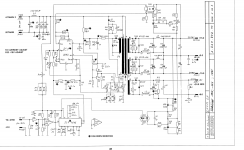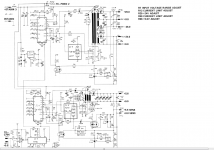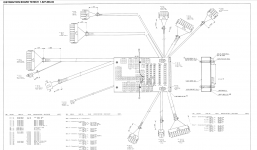Hi ! sorry for the question maybe weird.
All started with a suggestion made to me to try a smps to provide the needed single Voltage supply for some line preamp prototypes (still on paper 😱)
Actually i would use this power supply as a bench power supply to test some circuits good for line stage duties
Even if they are much noiser (usually from 100-300mV of ripple) than a normal linear supply the noise would be located outside the audio range and moreover easily suppressed with a proper RC or LC filter.
My need is a single voltage up to max 48VDC ... i still have one from Meanwell ... great brand i think.
Do you have any personal experience with smps for preamps ?
i have seen many high quality digital equipment using both smps and dc dc converters in their units.
What is your opinion ?
unfortunately i have already some smps and dc-dc converters to test but not spectrum analyzer to check for the noise distribution vs Hz
Also experience on dc to dc converter, both step up and step down would be very much appreciated.
For instance ... i understand someone is even using a battery stepped up to the voltage required. The circuits i am about to test will draw very little current ... some decimals of amp i mean ... no more than 0,2A total or so
Kind regards, gino
All started with a suggestion made to me to try a smps to provide the needed single Voltage supply for some line preamp prototypes (still on paper 😱)
Actually i would use this power supply as a bench power supply to test some circuits good for line stage duties
Even if they are much noiser (usually from 100-300mV of ripple) than a normal linear supply the noise would be located outside the audio range and moreover easily suppressed with a proper RC or LC filter.
My need is a single voltage up to max 48VDC ... i still have one from Meanwell ... great brand i think.
Do you have any personal experience with smps for preamps ?
i have seen many high quality digital equipment using both smps and dc dc converters in their units.
What is your opinion ?
unfortunately i have already some smps and dc-dc converters to test but not spectrum analyzer to check for the noise distribution vs Hz
Also experience on dc to dc converter, both step up and step down would be very much appreciated.
For instance ... i understand someone is even using a battery stepped up to the voltage required. The circuits i am about to test will draw very little current ... some decimals of amp i mean ... no more than 0,2A total or so
Kind regards, gino
Last edited:
With DC-DC converters there's no common-mode noise problem typically as they're not isolated in-out. So only normal mode filtration is called for - LC handles it. With mains-fed SMPSUs if you want the best audio quality paying attention to where common-mode currents flow is important, as well as the normal-mode filtration with LC.
Is your preamp balanced in? If so then pin1 takes care of any CM currents and you're good.
Is your preamp balanced in? If so then pin1 takes care of any CM currents and you're good.
Why SMPS? Why single supply? Single supply means a load of coupling capacitors.....
Hi ! yes ... one at the input and another one at the output
i will have to live with those like all the people who use tube preamps for instance (Not that i intend to use tubes by the way)
But dc offset at preamp level is to avoid absolutely i guess
Caps are very convenient
Even high quality equipment use coupling caps
The thing i do not like is that with single supply there is no separate ground
In a dual supply both the V+ and the V- are filtered 🙁
not so with a single supply
I think there are dc-dc converters with dual output ? i do not know for sure
With DC-DC converters there's no common-mode noise problem typically as they're not isolated in-out. So only normal mode filtration is called for - LC handles it.
Hi ! i have the feeling that this is a good thing ? 😱 well thanks a lot and very well 😀
this is difficult to understand. By the way ... i see someone using a 12V SLA battery and then step up its voltage with dc-dc converters ... is this a sane idea ? in this way i would get complete isolation from the mains grid. My circuits will draw very little current ... max 0.2A or soWith mains-fed SMPSUs if you want the best audio quality paying attention to where common-mode currents flow is important, as well as the normal-mode filtration with LC.
Therefore a battery charge could provide the needed power for some hours i guess
Unfortunately not ... all unbalancedIs your preamp balanced in? If so then pin1 takes care of any CM currents and you're good.

I need to check the sound of very basic schematics like those used as line outputs of famous tape deck like Studer and so on.
My reasoning is that as the sound coming from those decks was state of the art the circuits must also be state of the art.
Maybe the analog sound i like so much comes from those circuits ... usually single ended and very minimalistic
But noise is always noise ... i like dead silent silence
Last edited:
I use SMPS in a lot of my projects, including a B1 buffer, a Pearl I phono pre, a Zen Lite head amp.
Some of the smps are Vicor 48V, some are bricks at 24 & 48V.
All the smps I use are isolated in - out, meaning there is no common ground between input and output. I think that is a very important detail.
All working great, but always followed by a Cap Mx with a Mosfet and then some additional CRC.
My main speakers are 94 - 95 dB and there is no noise whatsoever.
Also just finished a dual mono ACA run at 48VDC with two Vicor 48V 200W, one per channel.
Forgot to add also two MoFo monoblocks using 24V bricks.
Some of the smps are Vicor 48V, some are bricks at 24 & 48V.
All the smps I use are isolated in - out, meaning there is no common ground between input and output. I think that is a very important detail.
All working great, but always followed by a Cap Mx with a Mosfet and then some additional CRC.
My main speakers are 94 - 95 dB and there is no noise whatsoever.
Also just finished a dual mono ACA run at 48VDC with two Vicor 48V 200W, one per channel.
Forgot to add also two MoFo monoblocks using 24V bricks.
Last edited:
The thing i do not like is that with single supply there is no separate ground
It makes sense to create one - 'signal ground' and call the other one 'power ground'. Join them together at your star point.
In a dual supply both the V+ and the V- are filtered 🙁
not so with a single supply
So dual supplies are double trouble.😱
this is difficult to understand.
You are right - common-mode noise is rather difficult to understand. But that doesn't make it an unimportant detail - its only unimportant when SQ isn't a significant issue.
By the way ... i see someone using a 12V SLA battery and then step up its voltage with dc-dc converters ... is this a sane idea ? in this way i would get complete isolation from the mains grid. My circuits will draw very little current ... max 0.2A or so
Seems fairly sensible to me - so long as you take care of the normal-mode noise filtering you'll be good.
Unfortunately not ... all unbalanced
Then its difficult to stop the ultrasonic mains leakage current flowing down your ICs.
I use SMPS in a lot of my projects, including a B1 buffer, a Pearl I phono pre, a Zen Lite head amp.
Some of the smps are Vicor 48V, some are bricks at 24 & 48V.
All the smps I use are isolated in - out, meaning there is no common ground between input and output. I think that is a very important detail.
All working great, but always followed by a Cap Mx with a Mosfet and then some additional CRC.
My main speakers are 94 - 95 dB and there is no noise whatsoever.
Hi ! thanks a lot for the very kind and valuable advice. As i said and unfortunately i have no access to a sprectrum analyzer to check the original noise spectrum and the effect of simple filtering ... i would like to cry for this
But i guess that decent spectrum analyzers are very expensive ?
It is an instrument i love ... as i strongly believe that all boils down to low distortion and low noise that would be the perfect tool to see these parameters ... one day i will have one. Now i am still working to get a salary 🙁 but when i will retire i will be free to follow my true passions ... money allowing of course 🙄
this i see as much more challenging ... preamps first. 😉 Little by little ...Also just finished a dual mono ACA run at 48VDC with two Vicor 48V 200W, one per channel. Forgot to add also two MoFo monoblocks using 24V bricks.
i am not sure to understand how to do it ... 😱It makes sense to create one - 'signal ground' and call the other one 'power ground'. Join them together at your star point.
But as a start i would like to understand why they are not more popular. I was looking at the noise and discharged the idea. Then i saw them used in dacs mostly ... with maybe other dc-dc converters on the circuits boards
And the measurements from them are usually ok (i.e. low noise and THD)
And to be honest what excited me price aside was looking at the MTBF 😱
I see datasheets declaring mtbf of about 1 million hours 😱
114 years ... this means that it could serve me possibly well for some time 🙄
yes ... that is what i suppose. I know about coupling caps ... but then i read an article from Millennia Audio. They use i guess dual supplies in their very high level mic preamps (a benchmark for transparency i understand)So dual supplies are double trouble.😱
but they have also cap coupled outs (i do not know about ins)
They use a parallel of not-polar high voltage electrolytics and small teflon caps
If they are ok for them they could be also good for me
You are right - common-mode noise is rather difficult to understand. But that doesn't make it an unimportant detail - its only unimportant when SQ isn't a significant issue.
Seems fairly sensible to me - so long as you take care of the normal-mode noise filtering you'll be good.
I am quite lost here ... i have some hopes to learn how to use an instrument and check. I have done some lab work and with time it was ok
But theory is a mess for me ... it is very hard for me to understand theory
With an instrument the result appear always on the screen and i would know if i am doing good or bad ... instruments do not lie.
sorry what do you mean with ICs ? the circuit will be all discrete ... not integrated circuits. I have the feeling the most of the analog sound of vintage equipment come from their circuitsThen its difficult to stop the ultrasonic mains leakage current flowing down your ICs.
I have just to feed them with clean power
I looked at the prices of good spectrum analyzer and i fainted ... 🙁
I am quite lost here ... i have some hopes to learn how to use an instrument and check. I have done some lab work and with time it was ok
Imagine a high frequency noise source (actually a current source) inside your mains-fed SMPSU which sits with one terminal on the primary (say mains neutral) and the other on the secondary (0V output) of the supply. Since mains neutral is referenced to safety earth, the noise current out of that current source is looking for a return path back to safety earth. If there are no safety grounded units in your system it'll make do with finding a way back to mains neutral via the parasitic capacitance of a mains transformer.
So you've got a large loop via your ICs (interconnects, not integrated circuits in this context) where a noise current is going to flow between your SMPSU-powered preamp and any other unit that has either a safety ground or a mains transformer.
The reason I developed my SilentSwitcher is exactly to provide extremely low noise supply that is totally separated from the mains.
It is particularly attractive for preamps, DAC, that sort of thing because a) power requirements are usually low and b) those circuits can be sensitive to mains hum and noise.
You can get then at the diyaudio store.
The SilentSwitcher | Linear Audio NL
Linear Audio Silent Switcher V3 – diyAudio Store
Jan
It is particularly attractive for preamps, DAC, that sort of thing because a) power requirements are usually low and b) those circuits can be sensitive to mains hum and noise.
You can get then at the diyaudio store.
The SilentSwitcher | Linear Audio NL
Linear Audio Silent Switcher V3 – diyAudio Store
Jan
YES , Studer A820...A827, the analogue recording industry's standard for a few decades ...It's actually full of switching supplies,heavily shielded , except the lower noise circuits have additional liniar regulators...
Attachments
Last edited:
That's hard to do. The SilentSwitcher has a pair of post-switcher linear low noise regulators.
The switching part makes sure they can be fed by a USB charger or, for total isolation, a Powerbank.
But to maintain very low noise there's the linear low noise regs.
Jan
The switching part makes sure they can be fed by a USB charger or, for total isolation, a Powerbank.
But to maintain very low noise there's the linear low noise regs.
Jan
USB chargers often emit EMI and they break down often. Not a solution for less electronic waste IMO.
What is gained left is lost at the right side a bit 😉
What is gained left is lost at the right side a bit 😉
- Home
- Amplifiers
- Power Supplies
- Anyone using smps with preamps ?


